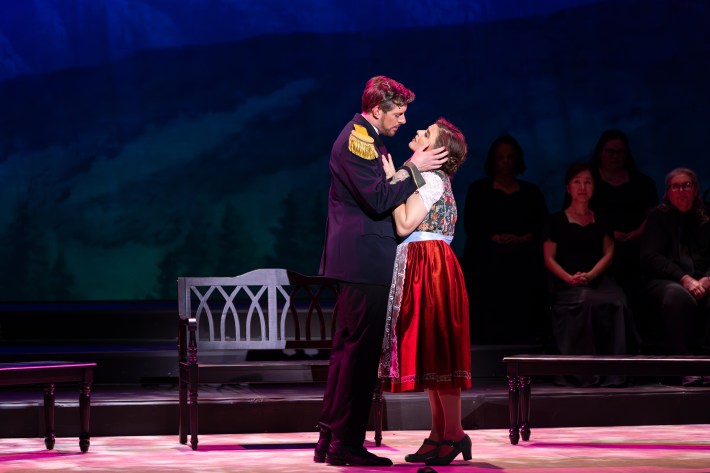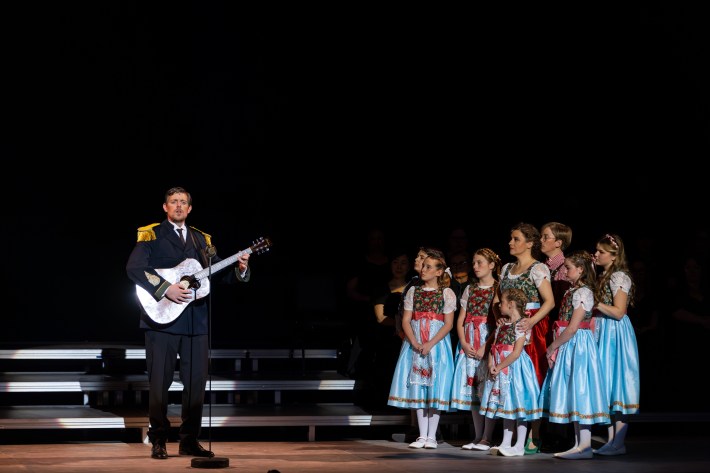Tulsa Opera: The Sound of Music
VanTrease Performing Arts Center for Education
November 15, 2025
While I’m an avid theatre-goer, opera remains a blind spot in my performing arts knowledge. To date, I’ve been to a total of two, including Tulsa Opera’s The Sound of Music, staged at the VanTrease Performing Arts Center for Education this past Saturday in a one-night-only engagement.
Tulsans go hard for opera. As I waded through the crowd outside and into the lobby, people were brimming with excitement. Inside the theater, I watched as adults found their friends in the audience and met them with wide grins. Kids of all ages, dressed to the nines (or in one case, a Captain von Trapp costume), ran around the aisles and climbed up onto the ledge of the stage to look down into the orchestra pit. The buzzing enthusiasm sustained throughout the whole performance, just as in the last Tulsa Opera production I went to.
When you think of opera, you probably don’t immediately think of Rodgers and Hammerstein’s final collaboration, a musical that retells the true story of the von Trapp family and their escape from the Nazis in 1930s Austria. I know the songs well and wouldn’t consider them operatic, but Tulsa Opera found ways to pepper that style into a stripped down performance.
One decision toward that end was to invite Leona Mitchell, an Enid native who spent 18 seasons as the leading soprano at the Metropolitan Opera in New York, to play Mother Abbess. While Mitchell struggled with some of the mid-range notes in “Climb Ev’ry Mountain”—I imagine it’s hard to switch from opera to musical theatre technique—she did sing beautifully and boldly when she had space to let a note ring. She also brought natural warmth to the stage. Her first scene with Jenn Gambatese (Maria), which included the song “My Favorite Things,” overflowed with joy.

Gambatese joined this show from Broadway, where she’s performed in productions like Footloose, Hairspray, and most recently Mrs. Doubtfire, as well as the first national tour of Wicked. She brought a Galinda-fied pluckiness to Maria that captivated my attention and created instant camaraderie with her castmates. She was especially excellent on stage with the youth performers who played the von Trapp children; she didn’t hold back, but also didn’t steal their moments.
Tulsa Opera Filstrup Resident Artist Sam Briggs stepped into the leading man role here. His Captain von Trapp was less strict than emotionally stilted, unsure how to open himself up to love again now that he’s a widower, and too scared to try. His unmelting was subtle but purposeful, leading to one of my favorite moments in this production, when Maria and Captain von Trapp confessed their feelings to one another. The tension between Gambatese and Briggs was palpable—so much so that their inevitable kiss elicited an uninhibited, gleeful shout from a young tween girl in the audience behind me, which began a bubbling chain reaction of young giggles and giddy murmurs throughout the audience. It was something you could only experience watching a live performance.

I’m quite impressed with how director Machele Miller Dill found ways to strip all the elaborate technical elements that we associate with Golden Age musicals down to the bare necessities. It made the elements that were included, like the unfurling of Nazi flags onto the stage during the von Trapp family’s concert performance, all the more climactic. Without set and costume changes, the performance had some empty space, but with the Tulsa Opera Orchestra, conducted by Artistic Director Aaron Beck, expertly bringing out the lushness of the score live, I enjoyed just sitting and listening to the music. My only technical complaint had to do with mics cutting in and out and poor sound amplification and mixing, which unfortunately affected some of the local talent and the youth performers the most.

Did The Sound of Music showcase Tulsa’s traditional opera capabilities? Not exactly. But the production accomplished something equally compelling: it highlighted the varied ways Tulsa Opera impacts the larger community—for instance, by including the Tulsa Opera Signature Chorale, composed of community singers, and choosing a production with strong roles for young performers, which ties into their Youth Opera program. Add a dance number featuring performers from Tulsa Ballet, strong local professional singers (Karlena Riggs, Christian Bester, Paige Dickey, and Maddie Breedlove) and two national stars, and you get a beautiful portrait of the many lives Tulsa Opera reaches. Like the musical itself, this production showed the power of what happens when we come together in unity.





